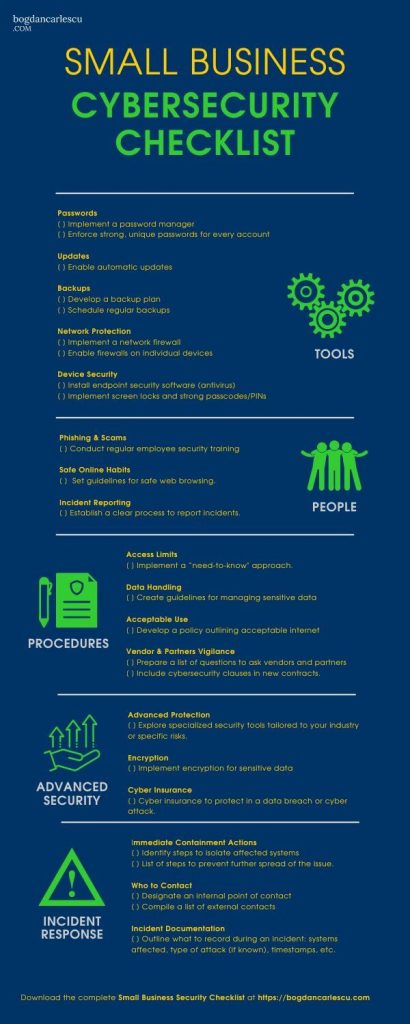As a small business owner, you’re in a nonstop whirlwind. Amidst the daily grind, cybersecurity might feel like it can wait. “We’re too small to be on a hacker’s radar.”, you may think. But here’s a stark reality: more than half of all cyberattacks target small businesses like yours. Why? Because hackers know you often lack the extensive defenses of big corporations. A single data breach could cause crippling financial losses, ruin your reputation, and disrupt your operations for ages.
But there’s good news! Getting strong cybersecurity doesn’t mean breaking the bank or hiring an IT army. Smart, strategic steps can protect your business against threats without draining your resources. This small business guide is your roadmap. We’ll cover the must-dos to safeguard your business, showing you that protecting yourself isn’t just smart – it’s essential for thriving in today’s world.

Ready to take charge of your cybersecurity? Download my free Small Business Cybersecurity Checklist and start building a stronger defense for your business today!
Essential Cybersecurity for Small Businesses
The Internet offers many opportunities for small businesses, but at the same time, it comes with risks. Knowledge of common cyber threats is the first line of defense. Understanding what you’re up against – ransomware that holds your data hostage, phishing scams that trick you into giving up sensitive information, and data breaches that expose your customers’ trust – is key.
Why Small Businesses are Vulnerable
It’s not just about the size or the value of your digital assets. Small businesses often face a higher cyber risk due to a few critical factors:
- Limited Resources: Unlike larger corporations with dedicated IT security teams, small businesses might have to make do with less, potentially leaving gaps in their digital defenses.
- Employee Oversights: The human factor plays a significant role. A simple click on a malicious link by an unsuspecting employee can open the door to a cyber attack.
- Underestimation of Risks: There’s a common misconception among small business owners that their enterprise is too small to attract cyber attention. This very belief can lead to inadequate security measures.
- Evolving AI-Enabled Threats: Cybercriminals are increasingly using sophisticated AI tools to automate attacks and find new weaknesses in systems. Small businesses, often lacking the resources to counter these advanced techniques, can be particularly vulnerable.
Beyond Tech: Security Mindset
Cybersecurity isn’t about tech tools only. You need to work on developing an organization-wide mindset where every employee understands the value of the information they handle and their role in protecting it. Establishing clear, practical policies and promoting an environment of ongoing vigilance can turn your team into an active part of your cybersecurity strategy.
- Shared Responsibility: Make it clear that cybersecurity isn’t just the IT department’s job; it’s a collective responsibility. From the front desk to the corner office, everyone plays a part.
- Simple, Clear Policies: Develop straightforward policies that guide behavior without complicating daily tasks. For example, establish clear guidelines for internet use, email handling, and mobile device management.
- Ongoing Vigilance: Cyber threats evolve, and so should your defenses. Regular updates, continuous learning, and open communication can help your team stay ahead of potential threats.
Empowering your business with a solid understanding of cyber essentials lays the groundwork for a robust defense. While incidents cannot be completely avoided, your organization will withstand threats and continue to operate even during adverse circumstances with the right mindset, technology, and processes. We call this cyber resilience.
Laying a Strong Cybersecurity Foundation
Establishing a secure foundation for your small business requires actionable steps that fortify your digital presence against potential threats. This foundation is built on a combination of essential practices and tools that can significantly enhance your cybersecurity posture. While AI enables a growing cyber threat landscape, it can also be a powerful defense. AI-powered security solutions continuously learn and adapt, detecting emerging threats and vulnerabilities that traditional methods might miss.
Password Power & Updates
Strong, unique passwords for each account and regular software updates form the bedrock of cybersecurity. Consider implementing a password manager to securely store complex passwords, eliminating the risk of reuse across different platforms. Concurrently, ensure that all software, especially operating systems and security applications, are kept up-to-date. These updates often include patches for vulnerabilities that, if unaddressed, offer an open invitation to cybercriminals.
Device Security (Antivirus)
Endpoint protection is one of the basic yet very important defense layers for your business. The antivirus (as we casually call it) constantly scans for and neutralizes cyber threats like viruses or ransomware before they can cause harm to your devices. While free versions provide basic protection, investing in a more comprehensive solution will enable more advanced features. AI-enabled protection, real-time monitoring, email protection, and phishing defense will significantly enhance your overall security.
Backups & Network Basics
Data backups are your safety net in the event of a cyber incident, ensuring that you can restore critical information and maintain business continuity. Develop a robust backup strategy that includes regular backups to multiple locations, such as cloud services and external hard drives.
Additionally, securing your network with a reliable firewall is crucial. This serves as a barrier between your business’s internal network and an external cyber threat, monitoring incoming and outgoing traffic to prevent unauthorized access. The software firewall on your devices will do the same while you work from remote locations.
Employee Awareness is Key
The human element can be the strongest or the weakest link in the small business cybersecurity chain. Prioritizing employee awareness and training can transform your workforce into a formidable line of defense. Focus on educating your team about the signs of phishing attempts, the importance of safe browsing habits, and the procedures for reporting security incidents. Encourage a culture where security is everyone’s concern, and empower your employees with the knowledge they need to contribute effectively to your business’s cyber security efforts.
By laying a secure foundation built on strong passwords, device security, regular updates, reliable backups, and an informed workforce, your small business can establish a resilient defense against the myriad of cyber threats it faces. This foundation not only protects your digital assets but also enables the overall growth and success of your enterprise in an increasingly connected world.
Protecting Your Business Critical Assets
You cannot establish a proper cybersecurity strategy without identifying and establishing protection for your critical assets. The assets potentially affected by cyber risks often include sensitive customer data, proprietary business information, intellectual property, and employee personal information. All are vital to your business’s integrity and competitiveness.
Identify & Secure Data
First, figure out where your most sensitive data lives – customer information, financial records, trade secrets, etc. Is it on company servers, in the cloud, or even on employee devices? Next, think about who really needs access to this data to do their jobs. Limit access to only those individuals, and ensure they have strong, unique passwords for each account. A password manager or central identity management (through Active Directory) can make this easier to manage.
Consider implementing basic encryption tools, especially for the most sensitive data. This is especially important on mobile devices that are more exposed to being lost or stolen. Encryption solutions are available for laptops and mobile devices, but also for cloud storage services. Even if hackers break into your system, encrypted data is useless to them.
Vendor Risk Management
The security posture of your vendors and partners can pose a cyber risk for your business. It’s important to assess and understand the cyber security measures of third parties that handle your data. Start by asking vendors and partners about their security policies and procedures. For new contracts, consider including clauses that outline the expected security standards and protocols.
This phase of your cybersecurity strategy is about taking proactive steps to not only safeguard your own assets but also to ensure that external partnerships do not introduce vulnerabilities into your ecosystem. By adopting a comprehensive approach to identifying and protecting critical data, and by carefully managing vendor risks, you can significantly bolster your business’s overall cybersecurity posture.
Next Steps & Cybersecurity Resources for Small Businesses
With a robust cybersecurity foundation in place, we can look ahead and continuously build upon it. The cybersecurity landscape is not static; threats evolve, your business scales, and so should your protective measures. A crucial aspect of this growth involves not just focusing on defense but increasing the overall cyber resilience of your business.
Incident Response and Cyber Resilience
As mentioned above, totally avoiding cyber incidents is not possible. Developing a basic incident response plan is an essential cyber resilience principle that you should consider. This approach means preparing not only for the possibility of a data breach but also for ensuring a swift, effective recovery.
Your plan should detail immediate containment strategies, impact assessments, and clear communication channels, all aimed at maintaining operational continuity in the face of any cybersecurity threat. Resilience is about turning potential disruptions into mere hiccups in your business journey.
Cyber Insurance
Cyber insurance is more used by larger organizations but it comes more and more available for small business too. It provides a safety net when cybercriminals manage to bypass prevention measures. It can cover various costs associated with cyber incidents, from legal fees to customer notification and recovery efforts. As your dependence on digital grows and the potential impact of a cyber attack increases, cyber insurance options could be a wise option to mitigate cyber risks.
Continuous Investing in Cybersecurity
Consider allocating resources to enhance your cybersecurity infrastructure as your operation grows. This might involve advanced tools, specialized talent, or external cybersecurity services. Viewing these investments through the lens of resilience emphasizes their role not just in protection but in the overall sustainability of your business.
Where to Learn More
The digital world is highly dynamic. As you embark on new business opportunities, keeping an eye on how cyberspace evolves will pay off dividends. Avoid spreading your attention thin and engage only with reputable sources such as CISA and NIST. These platforms offer a wealth of information tailored to the evolving cybersecurity needs of small businesses. You’ll find insights into both protective measures and resilience-building strategies.
Conclusion: Your Cybersecurity Journey
As we wrap up this guide, I want to point out that cybersecurity for small businesses is more than a checklist. It’s an ongoing journey towards creating a secure, resilient digital environment. By understanding the cybersecurity basics, laying a secure foundation, protecting critical assets, and preparing for incidents with resilience in mind, you’re not just safeguarding your business—you’re ensuring its continued growth and success in the digital age.
Embark on this journey with a proactive mindset, recognizing that each step, no matter how small, builds towards a stronger, more secure future for your business. The path to small business cyber security is paved with continuous learning, adaptation, and improvement. Start with the essentials and expand as your business evolves, always aiming for that balance between protection and productivity. Your business deserves no less.




